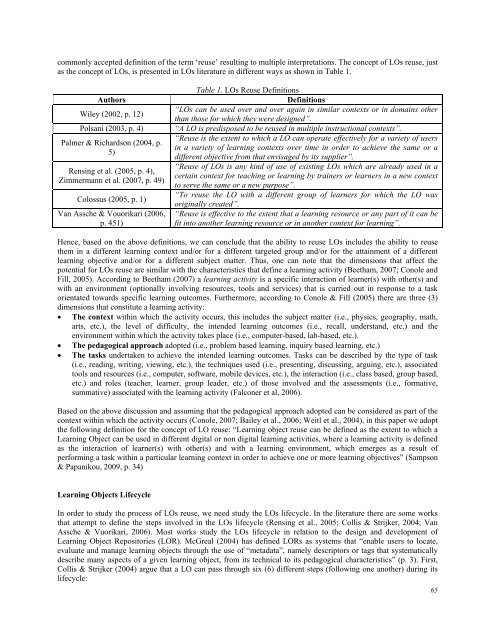October 2011 Volume 14 Number 4 - Educational Technology ...
October 2011 Volume 14 Number 4 - Educational Technology ...
October 2011 Volume 14 Number 4 - Educational Technology ...
Create successful ePaper yourself
Turn your PDF publications into a flip-book with our unique Google optimized e-Paper software.
commonly accepted definition of the term ‘reuse’ resulting to multiple interpretations. The concept of LOs reuse, just<br />
as the concept of LOs, is presented in LOs literature in different ways as shown in Table 1.<br />
Authors<br />
Table 1. LOs Reuse Definitions<br />
Definitions<br />
Wiley (2002, p. 12)<br />
“LOs can be used over and over again in similar contexts or in domains other<br />
than those for which they were designed”.<br />
Polsani (2003, p. 4) “A LO is predisposed to be reused in multiple instructional contexts”.<br />
Palmer & Richardson (2004, p.<br />
5)<br />
“Reuse is the extent to which a LO can operate effectively for a variety of users<br />
in a variety of learning contexts over time in order to achieve the same or a<br />
different objective from that envisaged by its supplier”.<br />
Rensing et al. (2005, p. 4),<br />
Zimmermann et al. (2007, p. 49)<br />
“Reuse of LOs is any kind of use of existing LOs which are already used in a<br />
certain context for teaching or learning by trainers or learners in a new context<br />
to serve the same or a new purpose”.<br />
Colossus (2005, p. 1)<br />
“To reuse the LO with a different group of learners for which the LO was<br />
originally created”.<br />
Van Assche & Vouorikari (2006, “Reuse is effective to the extent that a learning resource or any part of it can be<br />
p. 451)<br />
fit into another learning resource or in another context for learning”.<br />
Hence, based on the above definitions, we can conclude that the ability to reuse LOs includes the ability to reuse<br />
them in a different learning context and/or for a different targeted group and/or for the attainment of a different<br />
learning objective and/or for a different subject matter. Thus, one can note that the dimensions that affect the<br />
potential for LOs reuse are similar with the characteristics that define a learning activity (Beetham, 2007; Conole and<br />
Fill, 2005). According to Beetham (2007) a learning activity is a specific interaction of learner(s) with other(s) and<br />
with an environment (optionally involving resources, tools and services) that is carried out in response to a task<br />
orientated towards specific learning outcomes. Furthermore, according to Conole & Fill (2005) there are three (3)<br />
dimensions that constitute a learning activity:<br />
The context within which the activity occurs, this includes the subject matter (i.e., physics, geography, math,<br />
arts, etc.), the level of difficulty, the intended learning outcomes (i.e., recall, understand, etc.) and the<br />
environment within which the activity takes place (i.e., computer-based, lab-based, etc.).<br />
The pedagogical approach adopted (i.e., problem based learning, inquiry based learning, etc.)<br />
The tasks undertaken to achieve the intended learning outcomes. Tasks can be described by the type of task<br />
(i.e., reading, writing, viewing, etc.), the techniques used (i.e., presenting, discussing, arguing, etc.), associated<br />
tools and resources (i.e., computer, software, mobile devices, etc.), the interaction (i.e., class based, group based,<br />
etc.) and roles (teacher, learner, group leader, etc.) of those involved and the assessments (i.e., formative,<br />
summative) associated with the learning activity (Falconer et al, 2006).<br />
Based on the above discussion and assuming that the pedagogical approach adopted can be considered as part of the<br />
context within which the activity occurs (Conole, 2007; Bailey et al., 2006; Weitl et al., 2004), in this paper we adopt<br />
the following definition for the concept of LO reuse: “Learning object reuse can be defined as the extent to which a<br />
Learning Object can be used in different digital or non digital learning activities, where a learning activity is defined<br />
as the interaction of learner(s) with other(s) and with a learning environment, which emerges as a result of<br />
performing a task within a particular learning context in order to achieve one or more learning objectives” (Sampson<br />
& Papanikou, 2009, p. 34)<br />
Learning Objects Lifecycle<br />
In order to study the process of LOs reuse, we need study the LOs lifecycle. In the literature there are some works<br />
that attempt to define the steps involved in the LOs lifecycle (Rensing et al., 2005; Collis & Strijker, 2004; Van<br />
Assche & Vuorikari, 2006). Most works study the LOs lifecycle in relation to the design and development of<br />
Learning Object Repositories (LOR). McGreal (2004) has defined LORs as systems that “enable users to locate,<br />
evaluate and manage learning objects through the use of “metadata”, namely descriptors or tags that systematically<br />
describe many aspects of a given learning object, from its technical to its pedagogical characteristics” (p. 3). First,<br />
Collis & Strijker (2004) argue that a LO can pass through six (6) different steps (following one another) during its<br />
lifecycle:<br />
65

















